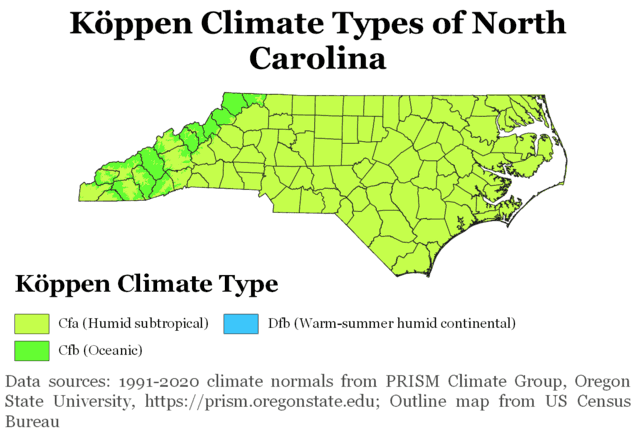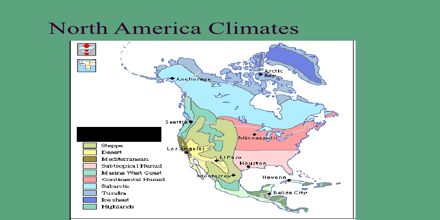Embarking on a journey through North Carolina is akin to traversing a vast canvas of climatic diversity, where the brush strokes of nature reveal a kaleidoscope of weather patterns stretching from the towering peaks of the Appalachian Mountains to the breezy shores of the Atlantic coastline. This dramatic transition unfolds within a mere few hours, wrapping visitors in a tapestry woven with distinct climatic characteristics that contribute to the state’s enchanting allure.
The climate in North Carolina varies significantly across its expansive geographical landscape, segmented predominantly by elevation and proximity to maritime influences. It is a land where each mile traveled leads one deeper into a unique atmospheric realm, revealing the complexities inherent to its topography.
To the west, the Appalachian Mountains rise majestically, their peaks often shrouded in mist. Here, the climate is classified as temperate, with an emphasis on cooler temperatures and robust precipitation, especially during the summer months. This region, punctuated by bucolic valleys and lush forests, embodies a climate conducive to the flourishing of biodiversity. The tall trees, primarily oaks and pines, serve as guardians against the elements, creating a serene ecosystem that thrives in the cool, moist air.
As the sun climbs higher and moves eastward over the state, the air warms and transforms. The foothills gradually descend into the gentle slopes leading to the Piedmont region, where the climate undergoes a subtle metamorphosis. Here, the temperatures in the summer months can reach sweltering heights, often merging with the humidity that rolls in from the coastal plains. The interplay between heat and moisture is reminiscent of a dance, with thunderstorms frequently punctuating the summer afternoons. It is this climatic dichotomy that fosters a rich agricultural sector, allowing for the cultivation of diverse crops such as tobacco, corn, and soybeans.
Transitioning to the eastern part of North Carolina, one encounters the coastal plain, where the maritime climate reigns supreme. The Atlantic Ocean exerts a significant influence here, moderating temperatures throughout the year. Summers are hot and humid, yet tempered by the ocean breeze, while winters are milder compared to the mountainous west. This climate creates a vibrant ecosystem filled with unique flora and fauna, thriving in the sandy soils and estuarine environments. Such conditions are ideal for the development of the renowned Outer Banks, a series of barrier islands that epitomize the charm of the coast—from expansive beaches to picturesque lighthouses.
Throughout all these climatic regions, North Carolina experiences a diverse array of weather phenomena, all shaped by the intricate interplay of geographic factors. For instance, hurricanes occasionally lash the eastern shores, a stark reminder of the fierce power of nature. Yet, while these storms may provoke discomfort, they also illustrate the dynamic balance of the weather systems that govern the state’s climate.
Moreover, the phenomenon of microclimates can be observed within this vast terrain. For instance, the elevations in the higher altitudes can create pockets of cooler air, which many plants and animal species have adapted to survive in. Such variety adds an intriguing layer of complexity, as it provides habitats for species that are not found elsewhere in the state. The unique convergence of climatic zones makes North Carolina a haven for environmentalists and nature enthusiasts, offering ample opportunities for exploration and appreciation of its diverse ecosystems.
As one navigates these climatic transitions in a single day, from the fresh mountain air to the sultry scents of the coast, there exists an evocative metaphor that mirrors the journey of life itself—constantly changing, yet beautiful in its diversity. Each locality presents a living tableau of resilience, adaptation, and beauty, reminding us of the ecological significance of maintaining a harmonious relationship with our environment.
Inspiring is the flora and fauna that thrive under such varied climate conditions. The iconic pine trees of the mountains, the flowering dogwoods, and the majestic magnolias of the coastal plains are emblematic of North Carolina’s rich natural tapestry. This variety not only enhances the visual appeal of the landscape but also plays crucial roles in the state’s ecological health. Healthy ecosystems provide services such as carbon sequestration, air purification, and habitat for wildlife, all integral to combating the far-reaching impacts of climate change.
Furthermore, the varied climatic zones present rich opportunities for scientific exploration and research. Understanding the intricacies of North Carolina’s climate can yield insights that are vital in the face of global climate challenges. The state’s educators, researchers, and conservationists engage in ongoing dialogues about sustainable practices that may mitigate adverse environmental impacts, further illuminating the interconnectedness of climate, flora, fauna, and human activity.
In essence, the climate of North Carolina is not merely a backdrop; it is a vivid character in the state’s ongoing narrative. From the majestic mountains to the serene coastline, it signifies both survival and thriving—the duality of existence. As we stand at the crossroads of nature’s own story, it becomes our collective responsibility to honor and protect this fragile environment for future generations, ensuring that the symbiotic relationship between climate and life continues to flourish.








